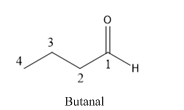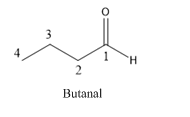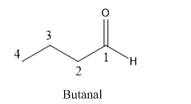
(a)
Interpretation:
The structural formula for the product formed by the treatment of Butanal with
Concept Introduction:
Butanal is a compound with four carbon atoms and −CHO group.
The structure of Butanal is as follows:

(b)
Interpretation:
The structural formula for the product formed by the treatment of Butanal with
Concept Introduction:
Butanal is a compound with four carbon atoms and −CHO group.
The structure of Butanal is as follows.

(c)
Interpretation:
The structural formula for the product formed by the treatment of Butanal with Tollen’s reagent should be drawn.
Concept Introduction:
Butanal is an aldehyde and the compound which have four carbons.
The structure of Butanal is as follows.

(d)
Interpretation:
The structural formula for the product formed by the treatment of Butanal with
Concept Introduction:
Butanal is an aldehyde and the compound which have four carbons.
The structure of Butanal is as follows.

Trending nowThis is a popular solution!

Chapter 17 Solutions
Introduction to General, Organic and Biochemistry
- Can I please get help with this.arrow_forwardDetermine if the following salt is neutral, acidic or basic. If acidic or basic, write the appropriate equilibrium equation for the acid or base that exists when the salt is dissolved in aqueous solution. If neutral, simply write only NR. Be sure to include the proper phases for all species within the reaction. N₂H₅ClO₄arrow_forwardPlease help me with identifying these.arrow_forward
 Introduction to General, Organic and BiochemistryChemistryISBN:9781285869759Author:Frederick A. Bettelheim, William H. Brown, Mary K. Campbell, Shawn O. Farrell, Omar TorresPublisher:Cengage Learning
Introduction to General, Organic and BiochemistryChemistryISBN:9781285869759Author:Frederick A. Bettelheim, William H. Brown, Mary K. Campbell, Shawn O. Farrell, Omar TorresPublisher:Cengage Learning Organic ChemistryChemistryISBN:9781305580350Author:William H. Brown, Brent L. Iverson, Eric Anslyn, Christopher S. FootePublisher:Cengage Learning
Organic ChemistryChemistryISBN:9781305580350Author:William H. Brown, Brent L. Iverson, Eric Anslyn, Christopher S. FootePublisher:Cengage Learning


